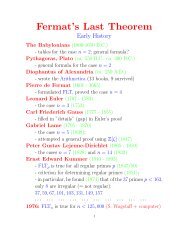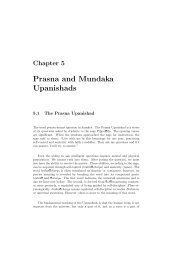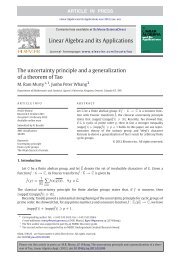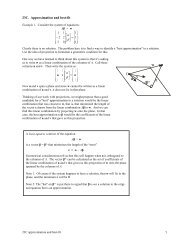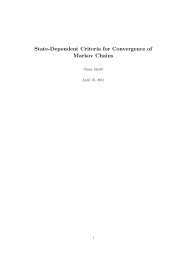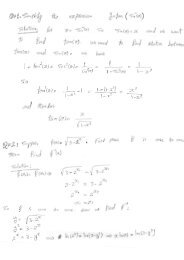Lecture Notes - Department of Mathematics and Statistics - Queen's ...
Lecture Notes - Department of Mathematics and Statistics - Queen's ...
Lecture Notes - Department of Mathematics and Statistics - Queen's ...
You also want an ePaper? Increase the reach of your titles
YUMPU automatically turns print PDFs into web optimized ePapers that Google loves.
4 CHAPTER 1. REVIEW OF PROBABILITY<br />
simple functions h n such that h n (x) → h(x) monotonically, that is h n+1 (x) ≥ h n (x). We define the limit as the<br />
Lebesgue integral:<br />
∫<br />
n∑<br />
lim h n (dx)µ(dx) = lim b k µ(A k )<br />
n→∞<br />
n→∞<br />
We note that the space <strong>of</strong> simple functions is dense in the space <strong>of</strong> bounded measurable functions on R under<br />
the supremum norm.<br />
There are three important convergence theorems which we will not discuss in detail, the statements <strong>of</strong> which will<br />
be given in class.<br />
k=1<br />
1.2.6 Fatou’s Lemma, the Monotone Convergence Theorem <strong>and</strong> the Dominated<br />
Convergence Theorem<br />
Theorem 1.2.3 (Monotone Convergence Theorem) If µ is a σ−finite positive measure on (X, B(X)) <strong>and</strong><br />
{f n , n ∈ Z + } is a sequence <strong>of</strong> measurable functions from X to R which pointwise, monotonically, converge to f:<br />
that is, 0 ≤ f n (x) ≤ f n+1 (x) for all n, <strong>and</strong><br />
lim f n(x) = f(x),<br />
n→∞<br />
for µ−almost every x, then<br />
∫<br />
X<br />
∫<br />
f(x)µ(dx) = lim f n (x)µ(dx)<br />
n→∞<br />
X<br />
Theorem 1.2.4 (Fatou’s Lemma) If µ is a σ−finite positive measure on (X, B(X)) <strong>and</strong> {f n , n ∈ Z + } is a<br />
sequence <strong>of</strong> non-negative measurable functions from X to R, then<br />
∫<br />
∫<br />
liminf f n(x)µ(dx) ≤ liminf f n (x)µ(dx)<br />
n→∞ n→∞<br />
X<br />
Theorem 1.2.5 (Dominated Convergence Theorem) If (i) µ is a σ−finite positive measure on (X, B(X)),<br />
(ii) g(x) ≥ 0 is a Borel measurable function such that<br />
∫<br />
g(x)µ(dx) < ∞,<br />
X<br />
<strong>and</strong> (iii) {f n , n ∈ Z + } is a sequence <strong>of</strong> measurable functions from X to R which satisfy |f n (x)| ≤ g(x) for<br />
µ−almost every x, <strong>and</strong> lim n→∞ f n (x) = f(x), then:<br />
∫<br />
∫<br />
f(x)µ(dx) = lim f n (x)µ(dx)<br />
n→∞<br />
X<br />
Note that for the monotone convergence theorem, there is no restriction on boundedness; whereas for the dominated<br />
convergence theorem, there is a boundedness condition. On the other h<strong>and</strong>, for the dominated convergence<br />
theorem, the pointwise convergence does not have to be monotone.<br />
X<br />
X<br />
1.3 Probability Space <strong>and</strong> R<strong>and</strong>om Variables<br />
Let (Ω, F) be a measurable space. If P is a probability measure, then the triple (Ω, F, P) forms a probability<br />
space. Here Ω is a set called the sample space. F is called the event space, <strong>and</strong> this is a σ−field <strong>of</strong> subsets <strong>of</strong> Ω.<br />
Let (E, E) be another measurable space <strong>and</strong> X : (Ω, F, P) → (E, E) be a measurable map. We call X an<br />
E−valued r<strong>and</strong>om variable. The image under X is a probability measure on (E, E), called the law <strong>of</strong> X.<br />
The σ-field generated by the events {{w : X(w) ∈ A}, A ∈ E} is called the σ−field generated by X <strong>and</strong> is denoted<br />
by σ(X).



